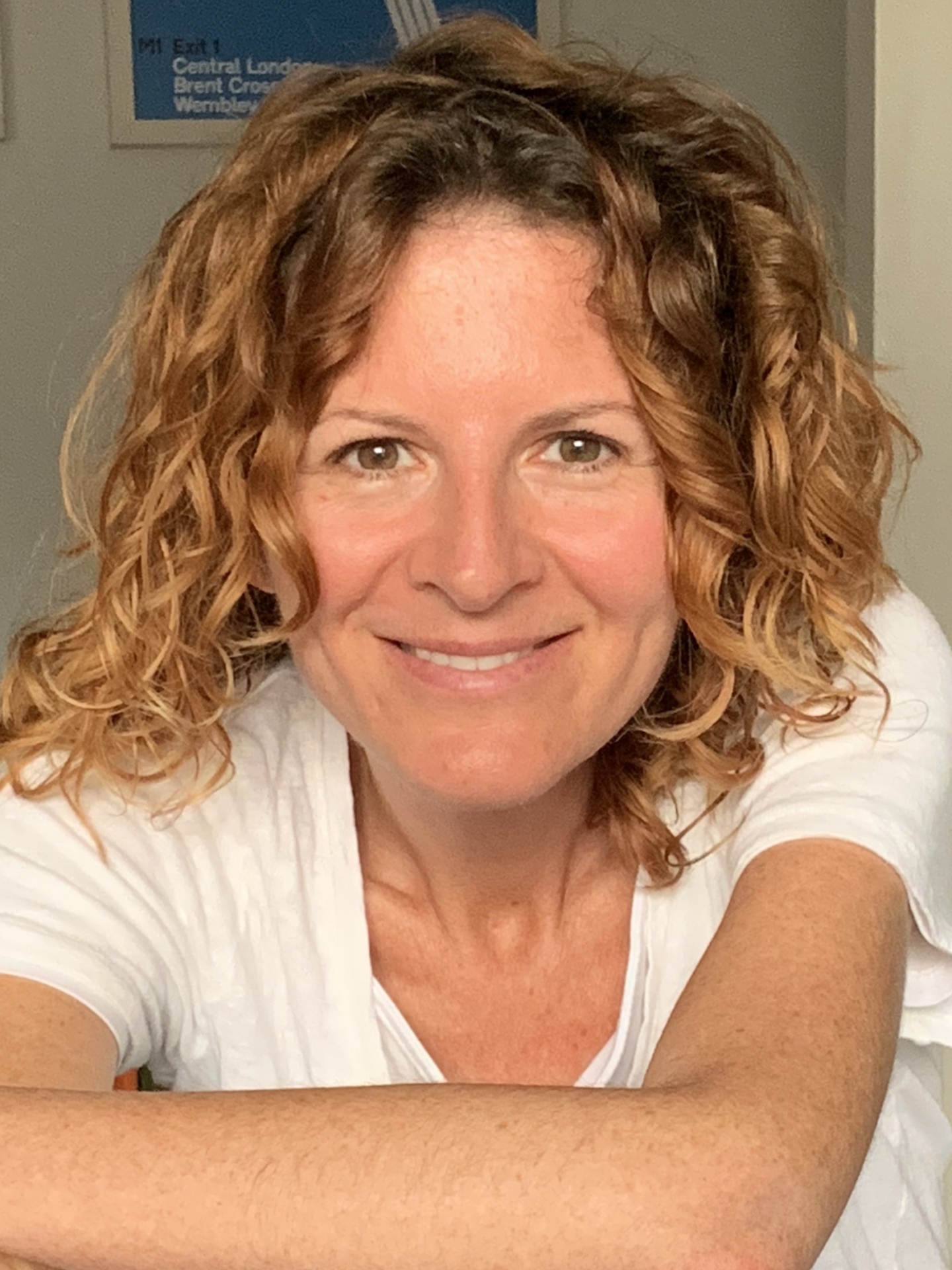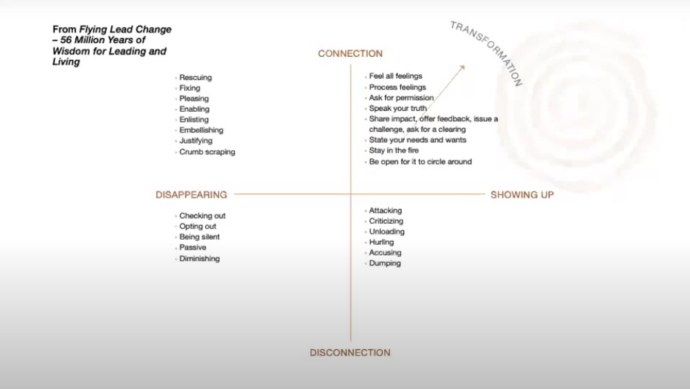An Awake Aware Arise session by Kelly Wendorf, MCC Founding Partner of EQUUS, and author of Flying Lead Change – 56 Million Years of Wisdom for Leading and Living (Sounds True)
Awake Aware Arise was a virtual conference lead by Coacharya for leaders, coaches and those who want to make a change – to truly Awake to the suffering in the world around them, become Aware of their responsibilities, and Arise together to act and be counted.
This virtual conference was from 21st September 2020 till 22nd October 2020, Monday to Thursday, with 3 sessions a day, to cater to international time-zones.
This blog is part of a series of blogs that is written by various Coacharya Alumni about the various learning they had in each session.
About the Author:

The focus of “Building Better Humans” with Kelly Wendorf was on how we can create broader, more robust, human beings not just to survive these unprecedented times but to thrive and flourish. This session introduced the key ideas presented in Wendorf’s published book, Flying Lead Change: 56 Million Years of Wisdom for Leading and Living, which combines nature-based sciences, contemplative wisdom, ancient indigenous principles and coaching to create a solution to the challenges of our times. It further extends Wendorf’s teaching with Coacharya on how to leverage presence in coaching in service of building better humans. Simply put, who we are and how we show up and create space for others is fundamentally dependent on learning, growth and real, deep and sustained transformative change, helping facilitate others’ as well as ourselves.
The call to action is discovering ways to do and be better both in the present and as we move forward. In this context, coaches can step-up as true leaders supporting and inspiring others to be their best selves whilst remaining authentically and perfectly human. This is about being able to meet people exactly where they are at. Wendorf reminds us, every single person matters in co-creating change and positive growth.
According to Wendorf the tools or framework for building better humans comprises a set of 5 Core Commitments:
- Take radical responsibility
- Feeling all feelings
- Be an ally
- Engage in courageous conversation
- Change optimal states into traits
1. Take radical responsibility
“I commit to taking full responsibility for the circumstances of my life and for my physical, emotional, mental and spiritual well-being. I commit to supporting others to take full responsibility for their lives too. I will refrain from blaming others and myself, from being a victim, hero or perpetrator.”
Taking radical responsibility is foundational to of all other commitments.
Commitment one encourages individuals to begin to look at the world in a different way through the process of becoming genuine learners instead of passive knowers by actively listening for insight instead of agreement. Doing so, requires trust, curiosity and a willingness to explore.
By taking 100% responsibility (no more and no less) for that which is within our agency to control, we have the potential to shift from either a powerless fear-based place (a victim, blame, shame, guilt cycle of things happening to me) and/or the need to ‘fix’ things for ourselves and/or others, to a space wherein the focus becomes one of reflective enquiry as we ask ‘What can I learn? Where can I grow? How can I facilitate others? How can I collaborate with others contributing my 100% whilst they also contribute their 100%?’ This is important as there is a very real difference between rescuing, empowering and teaching. Whilst, for some, it might seem laudable to strive towards problem solving and getting things done, we may not be aware of whether, in turn, our actions are keeping others small.
For Wendorf, this shift is at the heart of building better humans. Fundamentally, it is a shift from the intellectual (i.e. a cognitive idea) to an embodied knowing through a rewiring in our body, which might be felt through such things as posture, breathing, and calming of butterflies in the stomach. Each position (e.g. hero, victim, prosecutor) will take a different feeling.
Journal/ Reflective Exercise
Q1- Who or what do you blame for your unhappiness or frustration?
Q2- What is it costing you?
Q3 – What is one practical action step to shift responsibility back to you so you shift the responsibility back to you / feel more empowered?
2. Feel all feelings
“I commit to feeling my feelings all the way through to completion, the pleasant ones and the unpleasant ones. I commit to feeling them as sensations and will resist naming them, blaming them, judging them or numbing them.”
Feel all feelings, is concerned with presence in its purest definition. As humans we are conditioned to think about and feel emotions in particular ways. In committing to feeling all feelings, we are committing to embracing the full range of feelings (pleasant and unpleasant) that come with anticipating and co-creating change. A key part of Commitment two, is the practice of really feeling the fullness of every emotion; meaning the felt sense in our body.
We are asked to resist naming these feelings, judging them, or blaming them. When we label our emotions, we get what we call meta-emotions i.e. feelings we have about feelings (we can spiral into a rut!). This takes us away from pure presence. Instead, we are encouraged to allow all emotions to emerge and sit with them without interfering or trying to problem-solve them. This is about dropping into the very life force that is moving through us as a living thing connected to the cosmos, it’s quite an expanded state of being. This can help us with Commitment one as the greater capacity we have, the less need we have to fix or rescue.
Genuinely being with (i.e. being present with) another person(s) means being in tune both with ourselves and others. When as coaches we cannot deal with our feelings, then suddenly when our clients express those feelings, we do not know what to do with them. There is a beautiful place in between expression and repression (the sweet-spot), there we can just be and if we want to express those feelings, we can do it skilfully.
Journal/ Reflective Exercise:
Inviting you to remember a felt sense that was uncomfortable, not traumatic. It usually start with the memory and then the body reacts. Let it really have its way in its body and get acquainted with it. Where does it show? Is it soft, jagged, hot? Don’t label it. Be with that sensation exactly as it is, no agenda, not changing it.
The more you acquaint with it, the more granular your description can be. That means that you are not fighting it and therefore the more in detail you can observe it and be with it. The aim is not to let it dissolve, but to be able to experience it because it is.
3. Being an Ally
“I commit to learning about the differences and diversity in my community, my workplace, my country and with my clients. I will educate myself on how to be sensitive to others’ differences and be an ally for them in meetings, gatherings, family settings so that they feel included and not ‘other-ed’.
This is particularly important in American public discourse, as well as elsewhere around the world, given the atrocities associated with racism that have become entrenched in daily life. We need to be more aware and educated about the subtle way in which we exclude others if we want to begin to heal.
To be a genuine ally, one needs to be acutely aware of hierarchies of privilege and Subtle Acts of Exclusion – defined by Dr Tiffany Jana and Dr Michael Baran (2020) as subtle oftentimes non-deliberative behaviour that negatively impacts others by excluding and perpetuating stereotypes and oppression.
Understanding and addressing these interactions is imperative if we are going to create spaces that are more inclusive, collaborative, safer, and respectful. When we are an ally, we are cognisant of how individuals, groups and organisations subtly and systemically exclude others and are committed to learning about differences and diversity as it impacts our lives and work. We actively seek out how to become allies in the various social settings in which we interact– in our families, in the workplace, during gatherings etc., This is a collective effort; Wendorf reminds us, this is “where we need to go together in order to build better humans.”
4. Engage in courageous conversation
“I commit to being more honest in my communication with others. I will strive not to hide, drift, disappear, appease or attack, but be forthcoming and authentic in my engagements with others.”
The fourth commitment is concerned with the transformation that takes place when we show-up and (pro-)actively seek connection with others. It is in this space wherein courageous conversation can take place both with ourselves and with others.

This diagram taken from “Flying Lead Change – 56 Million Years of Wisdom for Leading and Living” by Kelly Wendorf illustrates the continuum between not showing up and showing up on the X-axis and the continuum of disconnection from self and others, and connection on the Y-axis.
- Disappear + Disconnect = Finger-pointing, blame, yell, attack, intimidate, dump
- Showing-up + Disconnect = Check, numb, disconnect
- Showing-up + Connect = TRANSFORMATION, feeling your feelings, respectful of impact, staying despite the conflict, ready to circle back because you require time to process.
- Disappear + Connect = Rescuer, justifying, pleasing appeasing, fixing. One interesting point in this quadrant is to differentiate between ‘rescuing’ – more negative, hold people small; and ‘empowering’ – more positive.
Journal/ Reflective Exercise:
Where are you normally and where would you want to be (most likely the Transformational)? Taking some time to reflect on this will likely indicate what it is that is more difficult for you and what, specifically, do you need to work on.
5. Change optimal states into traits
“I commit to actively engaging in my body’s neural-networks to rewire it towards positive traits such as resilience, kindness, connection, strength, happiness and joy.”
According to Rick Hansen, the author of the ‘Buddha’s Brain’, 33% of our personal attributes we are stuck with, meaning that there is another 66% that we can change, we can take charge of the person that we want to become.
This, the last of the 5 Commitments, is concerned with actively engaging with one’s own body’s neural network in order to rewire it towards positive traits, such as: resilience, kindness, connection, happiness, joy. A state is much more than an emotion. We have the potential to define our own states e.g. courage and where and what it feels like to embody it.
Wendorf reminds us that according to Dr Hansen’s research, there is a typically small conversion rate from insight to creating actual change in the average coaching session as clients are not shown how to ‘consolidate’ that state so that it becomes a trait. And yet, this is where the real magic happens. We were asked to personally reflect on those felt states that we felt would be really good for us individually to grow and to consider the following process for changing states to traits. We can become empowered to take charge of the person we want to become and as a coach, leader, facilitator and/or parent etc, we can support others to do the same.
This process starts by thinking of a feeling you want to have. Then, feel what that visceral felt state feels like in your body (for example, it might be the warm feeling we are aware of in our muscles or chest, a strengthening of our backbone or a relaxing of the jaw). Deliberately and consciously feel that experience for 2 minutes and then reflect on what, in particular, was rewarding about it. Trying to resist any feelings may lead to them becoming persistent. Wendorf invites us to commit to practice this regularly for 40 days before going to bed and to be mindfully aware throughout the day of where and when that feeling shows up for us. As we do so, it becomes possible to notice not only one’s internal reality shift, but also one’s external reality as it begins to reflect that visceral, felt experience.
Journal/ Reflective Exercise:
- Experience where you want to grow (remember a moment when you had that felt sense, or imagine what that might feel like)
- Extend experience deliberately and feel it somatically
- Focus on what’s rewarding about that experience
- Summon it again before you go to sleep
- Look for that experience throughout your day (repeat 1- 4)
Building Better Humans is being offered as a 30-hr elective. Please contact us for more details.
Watch the Building Better Humans Webinar



